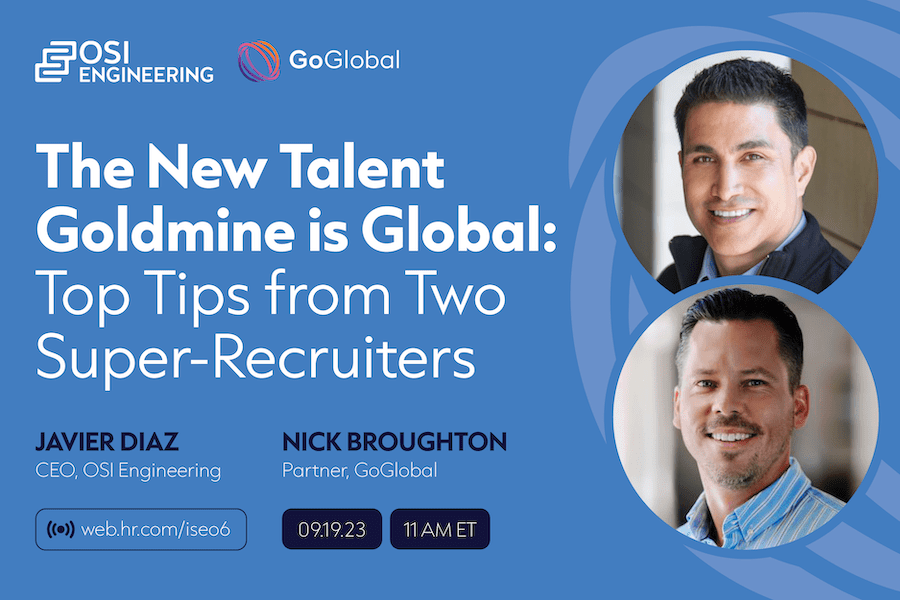The strategies businesses use to source talent are evolving at a pace like never before. As we navigate economic uncertainties and witness significant tech layoffs, the horizon of global talent acquisition broadens, presenting both challenges and opportunities.
The following offers an exclusive preview of the upcoming HR.com webinar on September 19th titled “The New Talent Goldmine is Global: Top Tips from Two Super-Recruiters.” In this Q&A session, we speak with Nick Broughton, Partner at GoGlobal, and Javier Diaz, CEO of OSI Engineering, to delve deeply into the transformative landscape of modern recruitment.
With remote work reshaping the talent landscape and digital technologies accelerating this transformation, talent acquisition professionals must understand how to strategically tap into the global pool. Discover the emerging hotspots for niche skills like AI, data science and cloud engineering, and grasp the intricacies of employment laws across diverse geographies.
Q: How are global talent and remote work revolutionizing recruitment practices?
Nick: Remote work disrupts traditional office norms, emphasizing efficiency over location. This has ushered in an era where companies can access a vast, previously untapped talent pool globally. At the same time, this shift demands a greater emphasis on cross-cultural communication, understanding of varying employment laws and the creation of inclusive workspaces that cater to diverse cultural nuances and time zones.
Q: How has the pandemic influenced the way we approach remote work and its impact on various companies and their work environments?
Javier: There is no way to talk about remote work without the mention of COVID-19, for it changed the entire way we think and go about work on a global scale. The post-pandemic working environment looks very different than it did just a few short years ago. While many companies have already shifted to a hybrid model, many today have transitioned to being completely remote. Remote work is no longer reserved for employees of large corporations. As we discovered, the benefits of remote work are vast, ranging from increased employee retention, to increased productivity, reduced operational costs and better overall business outcomes all while offering work-life balance. The net result is the ability to hire the best talent anywhere in the world.
Q: Where do companies begin if they want to look beyond their borders for talent?
Nick: The question of how to recruit globally is one that often comes up in conversations with companies looking to recruit and hire for hard-to-fill roles, especially technology, sales and client service positions. It can feel overwhelming when you consider how to even know where to start and how to remain compliant throughout the process. However, a potential solution for winning the ‘Race for Talent’ exists. By working with an Employer of Record (EOR) that is also able to recruit, companies can develop an end-to-end global recruitment strategy based on finding the right people for the right role at the right investment.
Q: We talked about the rise of global talent. OSI Engineering has been expanding into Latin America (LATAM). Can you shed some light into the regional demand and related remote work trends?
Javier: The demand for tech talent in LATAM continues to grow as businesses look to fill gaps in the workforce. This trend has been growing for the past several years. According to a report by LinkedIn, the most in-demand tech jobs in LATAM are software engineers, full-stack developers and data scientists. These positions are expected to remain highly sought after with many businesses looking to hire candidates with experience in the latest technologies. Along with this, remote work has become increasingly popular in LATAM with many businesses adopting a flexible working model to attract and retain top talent.
Q: What are some of the other talent hotspots?
Nick: As more companies try to strike the talent-price balance, we are seeing recruitment efforts pivot from legacy tech markets, like Silicon Valley, to more cost-effective talent pools. For example, many emerging countries offer young, well-educated workers who can bring fresh ideas and diverse perspectives to the industry. Countries like Argentina, Brazil, India and Kenya are just a few with diverse yet cost-effective talent pools. From our experience working closely with technology startups, it’s evident that the Middle East North Africa (MENA) region has become a hotbed of business opportunity with its vibrant startup ecosystem and extraordinary pool of talent.
Q: What else will you be covering in your HR.com webinar?
Javier: In addition to taking a closer look at the recruitment trends and landscape, the rise of the contingent workforce as well as global talent hotspots, Nick and I will discuss the DEI benefits of global hiring as well as the impact of AI and automation on recruitment. We’ll also explore the distinctions between independent contractors and employees.
Nick: The webcast will also address the pivotal, transformative role of an EOR in hiring talent and ensuring compliance with the employment laws of different countries. This session is geared towards global talent acquisition professionals and HR leaders aiming to expand their global talent pipeline.
Join Nick and Javier on September 19 at 11 a.m. EST for The New Talent Goldmine is Global: Top Tips from Two Super-Recruiters. This webinar qualifies for HR.com HRCI credits! Reserve your spot now: https://hubs.li/Q01-_PKm0
